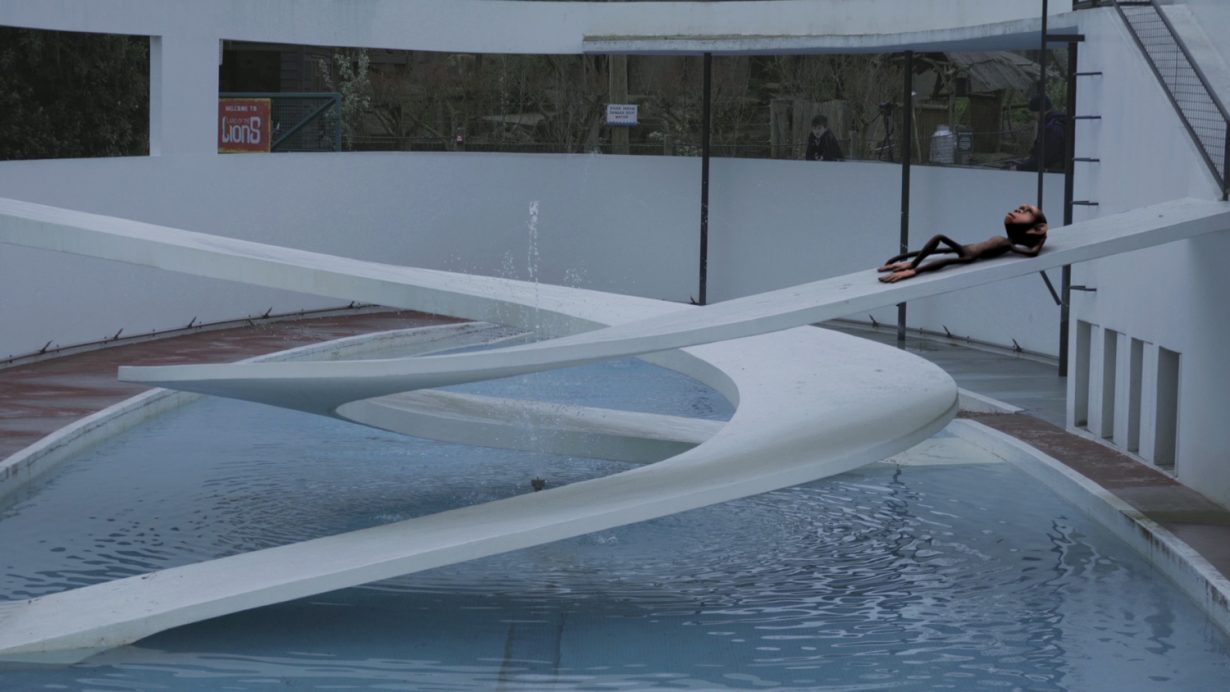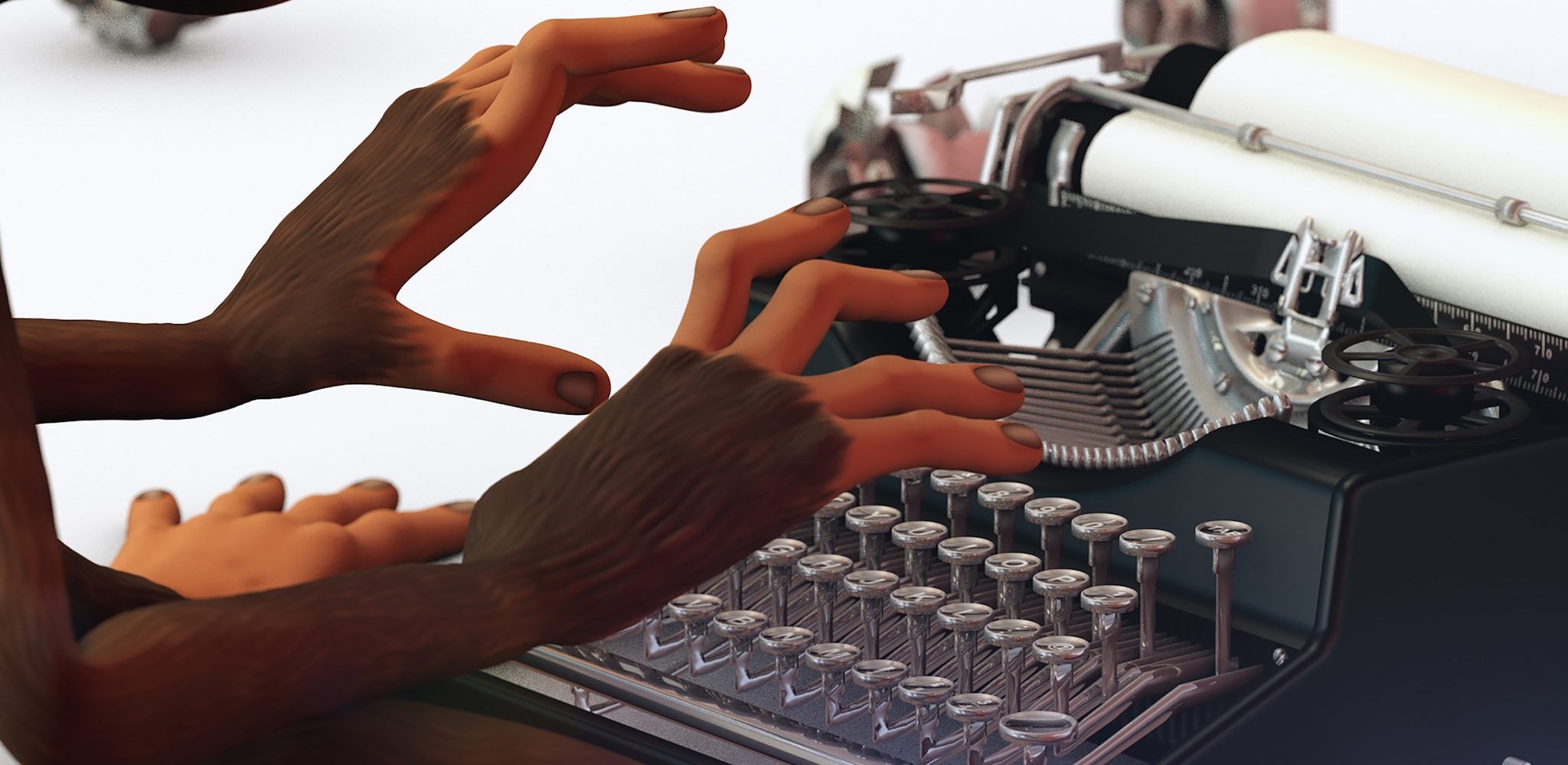The party’s over – the artist’s animated and meticulously digitally rendered animals are here to tell us we’re not so special
Animals have long acted as mascots for new technology: talking parrots helped define the new colour comics printed in newspapers at the turn of the twentieth century; a toy of Felix the Cat – a character first made famous in the comics – was one of the first images broadcast on television in 1928, the same year Mickey Mouse made his debut in the sound animations that were new in cinemas; while cat memes marked the spread of the internet. Furry faces are apparently one way to get humans to accept change, entertaining distractions that render the unfamiliar familiar (or at least cute) and that distance us from any blame that might come about as a result of the upheavals that follow. It seems, then, in the same tradition that British artist Ollie Dook’s videos and installations of the past few years have been guided by CGI monkeys, elephants and goats. But unlike the animal icons that came before, Dook’s menagerie isn’t very happy to be here.

stereo sound, 4 min 7 sec. Courtesy the artist
“He’s just dancing! Doing that back and forth,” we hear a kid exclaim excitedly in one section of Animal Stories (2018), a five-part short CGI video that draws on viral footage found online of animals behaving in ways that humans apparently find amusing. The scruffy, baggy-eyed polar bear in front of us isn’t dancing, though; it’s just sitting on the ground, dejectedly staring at a phone it holds in one paw, scrolling with a claw from the other, a single spotlight twirling about nearby. In another section of the video, a bored lanky monkey picks up a selfie stick with a phone mounted at the end, coyly making faces for the camera before taking a snap. The same animated monkey appeared a year earlier, leading us around London Zoo in the short video Reflections on a Visit V2 (2017). There, he stands in front of a snake enclosure, speaking with a young boy’s voice, offering a tongue-in-cheek monologue on the benefits of zoos: “If we concentrate all the animal world into one place, and fasten them into little enclosures like this… we can emerge from the zoo with a sense of human pride and a sense that we are something special”. The animal mascot might traditionally be a marker for how far humanity has come, a celebratory embodiment of new possibilities. In Dook’s work, the party is over. These animated and meticulously digitally rendered animals are here to tell us we’re not so special, or just plain delusional, and that all that makes us human is simply our insistence on being human, as something else, other, exceptional, more. That insistence has only led us down a path of isolation, walking with a self-exulting swagger into a deserted enclosure of our own making.
The young London-based artist’s work spans various forms of multimedia collage, drawing in photographs, found footage, videogames and CGI to create densely layered videos that are sometimes situated within sculptural installations. In Of Landscape Immersion (2018), viewers stand among see-through partitions, fake rocks and stunted tree trunks in order to watch the short video, a macabre mood-piece filled with flickering lights and stones dangling from chains in an empty chamber. A CGI chimp appears occasionally, clutching at bamboo cage bars, but it seems, as the video goes on, that it has broken free and we’re the ones left abandoned in the dark enclosure. Dook’s most recent work, Proboscidea Rappings (2019), offers a séance with Jumbo, the elephant who became a Victorian media and branding sensation. A digital rendition of the celebrity pachyderm towers over us, in a video projected onto a monolithic, almost-four-metre-high vertical screen. The soundtrack swells with melodramatic cinematic strings, while in a monotone voice Jumbo describes the upheavals and depression it suffered. “Yes, the days seemed golden, but the nights, the nights they were black,” it says, while swigging a bottle of red wine.

Jumbo’s tale offers a rare narrative thread in Dook’s work, but more often it’s as in Landscape Immersion: melancholic and claustrophobic explorations of entrapment, exploring the mock jungles and glaciers constructed in the pretence of an appropriate environment for whichever animal is being held there. Mediating all this is a foregrounding of barriers, screens and windows: everything seen in the videos is through cage bars, smudged glass, fallen trees and, most familiarly, the thousands of minute scratches of an old screen, as if this is all just being watched on a phone. This is work obsessed with boundaries and limits – of what we can see, of what we know, and the paradox that the technology that seems to enable us to look across those boundaries might actually create and perpetuate such limits.
Of course, the animals aren’t actually the point in Dook’s work; like the other techno-mascots, they’re more a kind of mirror, reflecting our own aspirations and dreams. As academic E.J. White writes in her introduction to A Unified Theory of Cats on the Internet (2020), cat memes are ‘a symbol of japoniste technomodernity, youth-culture rebellion, cyberpunk aggression, and the weirdness and transgression that once seemed to mark internet culture as an authentic space that was separate from the mainstream’. Or as Robert Feild put it in his 1942 book, The Art of Walt Disney: ‘What is Mickey anyway but an abstract idea in the process of becoming?’
Esther Leslie mentions Feild’s question in Hollywood Flatlands (2002), her study of the overlaps between the origins of animation and avant-garde art during the first half of the twentieth century. She goes on to describe Walter Benjamin’s writings on Mickey Mouse, which portray the cartoon mouse as a figure that both instructed viewers in the contradictions and alienations of contemporary life, and offered a vision of an elastic, hybrid place in which technology and nature were already combined. The cartoons showed people that ‘the “human” is a lie’, as Leslie puts it. ‘Existence is technoid.’ Life is already cross-fertilised, mutant and cybernetic, slipping beyond easy definition or distances whether we want to acknowledge it or not. These animated animals, as in Dook’s work, aren’t so much receptacles for humanity, but constructed embodiments of its techno-other, everything humanity wants to be but fears becoming – mechanical and malleable, spontaneous and immortal. Benjamin casts Mickey as a herald of sorts, beckoning towards an embrace of technology as the way to modernity. Now it seems like a warning we might have heeded, or instruction we might have better learned: the keys to accepting a hybrid reality were in front of us, we just saw them as cheap cartoons. Cute cat memes, in this light, are more like sirens, calling us into a room of wall-to-wall touchscreens and then locking the door behind us.

Beyond the animated primates and CGI fur, the wider question in Dook’s work might be what we can see from within this technoid horizon. Smashing Windows (2016) is a collaged video of what looks like YouTube and computer game footage that indexes different methods, as the title suggests, of breaking barriers. We see: a bathroom fill with water until the floor gives and the entire contents crash into the sitting room below; a first-person shooter in a videogame jumping through a window; a series of gorillas rushing and crashing into the glass barriers that line their enclosures. It’s an anxious atmosphere, where nothing happens but smashing and waiting for things to be smashed. It might, on the surface, seem to advocate violence as necessary, but water and light leak through the gaps made, and every breach and every hole made just seems to lead to another enclosure. There is no escape. Smashing Windows embodies much of the uneasy sensibility around Dook’s work, and also points towards current work-in-progress looking at memory loss and how what is recalled is defined by how we’ve recorded it. Smashing Windows suggests that we’re constantly looking to break out, preoccupied with the fantasy of smashing free, but that the dream of escape is a distraction, a constant existential leak. Instead of considering ourselves separate, above, constantly looking to be elsewhere, the melancholic mascots and incessant dead ends in Dook’s work asks if humans might finally see the cartoons for what they are, and take our digital lives at face value. Stop, have a look around and admire the new uncanny flora and fauna on offer. Then we might get over ourselves and see the world that is actually around, and beyond us.
Chris Fite-Wassilak is a London-based critic and author of The Artist in Time (2020)
